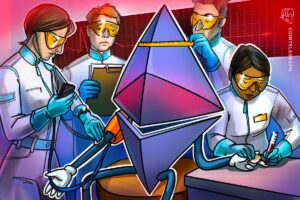Vitalik Buterin unveils roadmap for Ethereum layer-2 interoperability

TLDR
Vitalik Buterin plans for cross-chain connectivity between Ethereum layer-2 networks. The plan includes several Ethereum Improvement Proposals (EIPs) aimed at improving L2 compatibility, cross-L2 connectivity, and EIP-3668 for off-chain data access. He predicts, however, that this transition may take more than 5 years, with VanEck predicting that Ethereum's L2 scale networks could reach a $1 trillion market. In six years, Cap
Ethereum founder Vitalik Buterin has proposed a comprehensive plan to solve one of the most pressing challenges in the cryptocurrency ecosystem: cross-chain interoperability between Ethereum layer-2 (L2) networks.
In a series of posts on social media platform X, Buterin outlined his vision for a seamless user experience across the entire “Ethereum-verse”, highlighting several key ideas and technological developments that could make this a reality.
Cross-L2 roadmap in one tweet:
* 3770 (cross-L2 addrs)* 7683 (cross-L2 sends via liquid providers)* 3668 (L2 light clients)* Cross-L2-playable account status updates
The above is already enough. Later, step 2:
* L1sload/static call * Keyystore rollups * Verification sum
— vitalik.eth (@VitalikButerin) August 5, 2024
The roadmap Buterin shared focuses on a set of Ethereum Improvement Proposals (EIPs) designed to improve L2 compatibility. One major idea that introduces a new level of addressing is the EIP-3370.
This standard requires wallets and decentralized applications (dApps) to expose chain-specific addresses with human-readable prefixes, greatly simplifying the user interface and reducing the potential for error when connecting to different L2 networks.
Another important part of the plan is EIP-7683, which aims to establish a standard communication protocol for different Ethereum L2 networks. This idea addresses the inefficiencies and complexities that users face when trying to trade assets across multiple chains. By implementing a uniform set of rules, the EIP-7683 can streamline mid-chain transactions, making it easier and more efficient for users to move assets between different L2 solutions.
EIP-3668 is also on the agenda, providing a standardized method for obtaining off-chain information for Ethereum smart contracts. Buterin calls this “layer-2 light clients,” explaining that it makes it easier and more cost-effective for developers to build data-intensive applications without incurring high on-chain storage costs.
In addition to these ideas, Buterin discussed the concept of “cross-L2-replayable account status updates,” which he previously explained in a 2023 blog post. This approach allows L2 networks to receive the latest Layer-1 (L1) status updates while maintaining security and low latency, further enhancing connectivity between different Ethereum ecosystems.
Looking ahead, Buterin mentioned a number of Phase 2 updates to further improve the chain's L2 compatibility, including keystore packages and checksums. He emphasized that the initial “Level 1” improvements were independent of package technology specifics, suggesting broad applicability to a variety of L2 solutions.
Regarding the future of existing zero-knowledge (zk) and optimism, Buterin predicts that all scrolls will eventually migrate to zk technology, ending transactions into Ethereum once per slot. However, he estimated that this transition would take more than five years to fully materialize.
The Ethereum co-founder's optimism for solving cross-L2 interoperability issues is shared by some in the investment community.
Earlier this year, investment manager VanEck predicted that Ethereum's L2 scale networks could reach $1 trillion in market capitalization within six years, highlighting the enormous potential of Buterin's vision for cross-chain connectivity.
However, Buterin recently addressed concerns about overly complex Layer 2 scaling solutions, highlighting the potential risks associated with complex L2 networks.
He urged a more balanced approach to the development of blockchain ecosystems.













